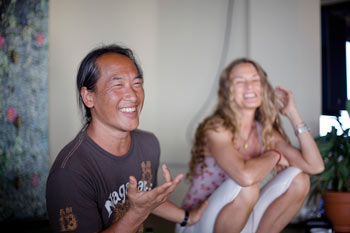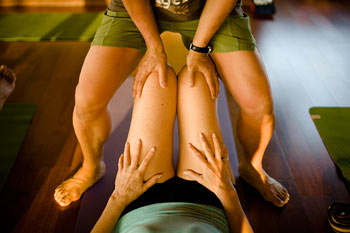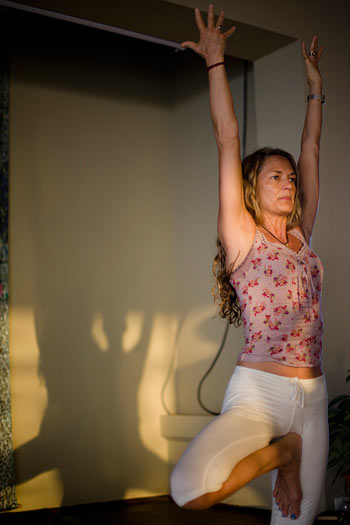The conversation between The Voice of Nosara and world famous yoga teachers, Rodney Yee and his wife, Colleen Saidman continues with a focus on gender roles in the yoga world, their travel motivations and GAIAM Online Yoga Club. To read the first part, please click here.
VON: I would like to talk with you about gender roles in yoga practices. I don’t personally practice yoga but I have read that many men are hesitant to practice yoga because of gender roles and the fear that comes with it. What do you think about this?

|
|
RY: That’s ironic also, right? Because the history of yoga is in some way pretty male dominant. And now, in the modern times with the whole body image thing . . . Yoga is about possibility, about taking these different positions, and exposing your body, being exposed in some ways, a lot of men are like “No way! I don’t want the exposure. I don’t want to feel inadequate. I don’t want to feel incapable. I don’t want to feel unskilled.” So it is an image problem. But the irony is that they don’t even know what it is. So through the media, they think, “Oh, this is what it is. I am not good at that. I am not going do it.” But Colleen actually swims against the other. She thinks that leaders of yoga are mainly male. So I’ll let her talk about that. |
CS: I think that’s changing, too. But there are a lot of men in class now. I think that change came four or five years ago. Like this morning we had 40 people in class. Of the 40, 17 were men. In my weekend classes and in my evening classes, it is usually about 40% men. Up until a few years ago, the conferences were mainly male teachers and female participants. But I think that it is coming more back into balance at this point. It is sort of maybe 60% men teachers and 40% women teachers at the conferences now, and it is probably 30% men and 70% women participants. So it is coming together.
VON: How was it in India in terms of the gender roles and male participation in yoga?

|
|
RY: I mainly, again, studied with the Iyengar. And Iyengar, himself, is such a, you know, in some ways like an Einstein of yoga, if you will. But at the time I was there he basically said his daughter was at that level. So he gave his daughter a lot of credit and his daughter was fierce and still is. They are both fierce. So for me during a certain period of time, I had a woman and a man to really think of as incredible teachers and gurus. So I didn’t see what was the common thread in India necessarily.
|
CS: I didn’t study yoga in India. I’ve taught there and I’ve lived there. But I haven’t really studied yoga there. I worked there with the Missionaries of Charity in Calcutta.
VON: What keeps you going on your travels, teaching, and workshops for over 30 years? What is your motivation?
RY: As we get older, it is a little more exhausting. But I think both of us love to teach. You know, it is just a love of sharing something that is so important to yourself and seeing that other people are getting something big from the same thing you have gotten. So that sharing is I think the thing that gets us up out of bed and into the classroom.
 |
|
CS: Certainly, I can’t imagine somebody living without it. It is like “Com’on! Don’t you guys see this is…You can’t live without this.” I really literally don’t understand how people get by without yoga. It is almost a responsibility at this point. I mean just this afternoon, people that come up go “Oh my God! I didn’t realize that I wasn’t using my lungs for breathing. Oh my God! I didn’t realize my head and my chest were connected. It made such a difference in my life.” I think it is really important and that’s what keeps us coming back. And yes we are tired. And yes we do travel, too much.
|
VON: How did the idea of an online yoga community, GAIAM Yoga Club, come about? And why did you start that?

|
|
RY: Actually I wrote a book with a co-author, called Moving Towards Balance: 8 Weeks of Yoga. Initially that was sort of the framework, in which to start an online club. And then, Colleen and I worked arduously to turn some of that book and then get new material to actually start a viable online club that would teach people, not only have people practice at home, but it would teach them how to practice at home, how to trust themselves, how to listen to themselves, how to sequence. So you know a lot of people when they come to class, they will come to us and they will say, “I don’t practice at home, cuz I don’t want to do it wrong.” or “I need you to lead me.” And so we wanted to address that basic thing and so “How are we going to teach someone how to trust themselves within their own practice?”
CS: And to stop getting hurt, to do things very safely. We always say that of all the things we’ve done, the one we are the most proud of is the GAIAM.
VON: Have you ever received any negative feedback on that in terms of lack of the physical presence of a teacher?
|
RY: Not really. It is pretty comprehensive. Of course, it doesn’t replace a physical teacher. There are so many things that it falls short of. So it doesn’t replace a one on one classroom or a live classroom.
CS: But it is a lot less expensive than flying to Costa Rica.
RY: But it can set you up. And for a lot of people, that are scared to go to a class, they are scared to go in unskilled and feel embarrassed. So this is a stepping stone.
CS: You know there are three or four, even five students here that are teachers and have been teachers for a long time. They do the GAIAM Yoga Club every day because it gives them the sequencing and the alignment that they have been taking to their classroom and teaching. A lot of times, they’ll just pick out one of the days, and say “OK, I am just going teach this today.” And they know it is a good practice. So it is for beginners all the way up to teachers.
In the last part of these interviews, Yee and Saidman will be talking about Urban Zen Foundation, an NGO with a focus to change the current health care paradigm. It is founded by Donna Karan, an American fashion designer. Also, they will mention about the western medicine system, current health care systems and their collaboration with NGOs.
To read the first part of the interview, please click here.
INTERVIEW HAS BEEN CONDENSED AND EDITED.
|

